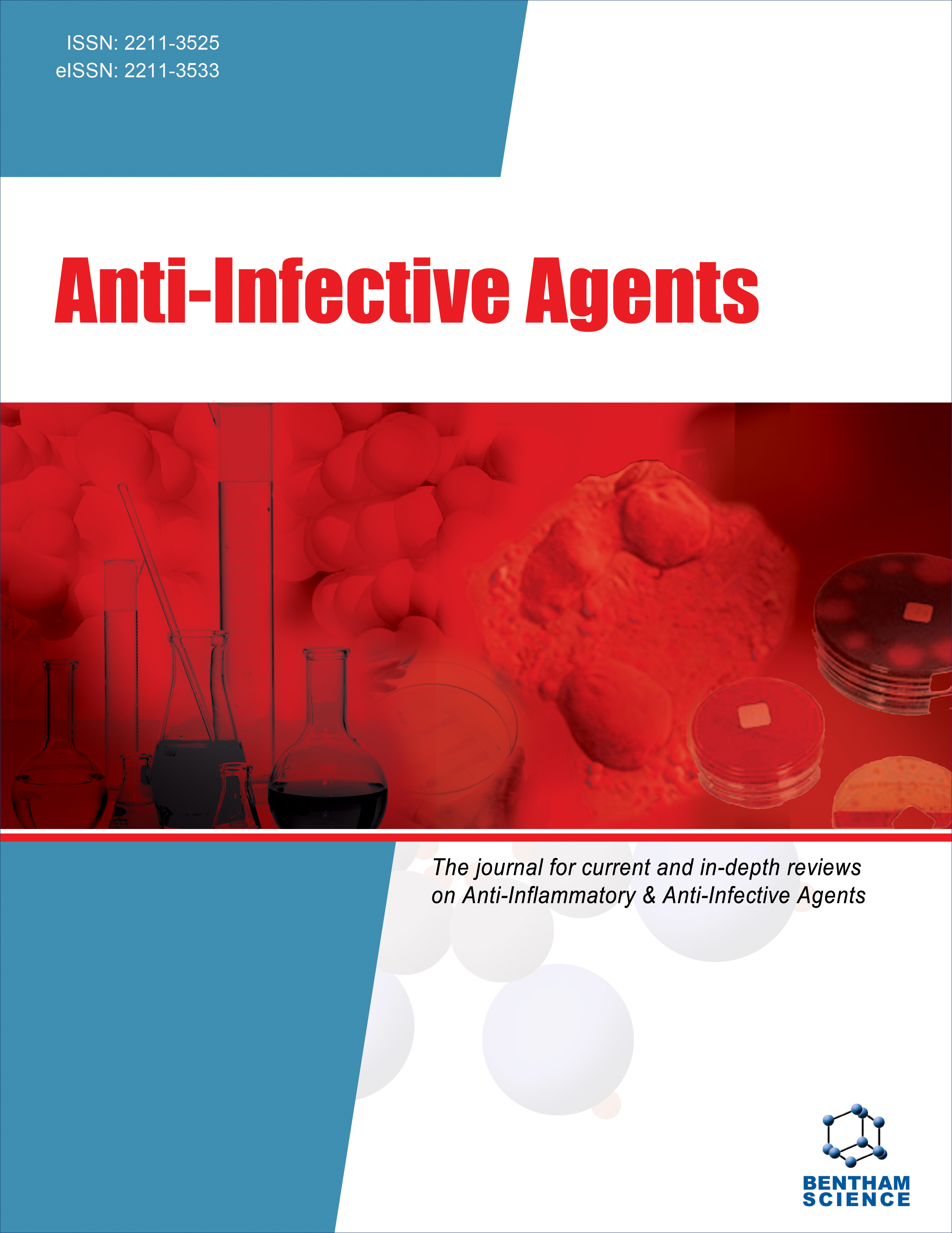- Home
- A-Z Publications
- Anti-Infective Agents
- Previous Issues
- Volume 22, Issue 3, 2024
Anti-Infective Agents - Volume 22, Issue 3, 2024
Volume 22, Issue 3, 2024
-
-
Cavity Disinfection with Natural Agents and their Efficacy: A Review on Recent Literature
More LessAuthors: Sreejeeta Dey and Seema DeshmukhThe success of a dental restoration can be altered by the amount of residual bacteria present under the cavity which over time cause deterioration of adhesive cement by microleakage or secondary caries. Cavity disinfectant application on the cavity walls performs a cleansing action to decrease the bacterial load and improve the longevity of restorations. Although a wide variety of such chemical disinfectants have been Read More
-
-
-
Prevalence and Antibiogram of Escherichia coli Isolated from Children Under Five Years of Age Presented with Acute Diarrhoea: Cross Sectional Study from a Tertiary Care Centre in South India
More LessAuthors: Santhosh J. Thattil and Thekkuttuparambil A. AjithAim: The study aimed to analyze the prevalence and antibiogram of E. coli isolated from stool sample cultures collected from children below five years of age who were presented with acute diarrhoea in a tertiary care centre. Background: Multidrug-resistant strains of diarrheagenic E. coli remain a major public health concern for greater morbidity and mortality. Antibiotic resistance and susceptibility patterns of E. coli were Read More
-
-
-
Development of Phytoconstituents from Spathodea campanulata Flowers as Potential Antimalarial Agents
More LessBackground: Considering the majority of pharmaceutical firms focus on using herbal remedies as an alternative source of essential components, herbal remedies are extremely significant to pharmacological researchers. Spathodea campanulata is one of the members of the Bignoniaceae family. It is popular for its curative properties. Aim: This research aimed to assess the possibility of bioactive elements and antioxidant i Read More
-
-
-
Use of Pharmacophore Modeling, 3D-atom-based QSAR, ADMET, Docking, and Molecular Dynamics Studies for the Development of Psoralen-based Derivatives as Antifungal Agents
More LessBackground: The mortality and morbidity rates in patients caused by fungi are extremely high. 3-4 % of species of fungi like Candida and Aspergillus are responsible for >99% of invasive fungal infections. Aim: The goal of the current work was to use several In-silico methods, such as Pharmacophore modeling and 3D-QSAR, to design New chemical entities (NCEs) that have antifungal activity. Materials & Methods: A da Read More
-
-
-
Potentials of TPC and TFC as Free Radical Scavengers and Microbial Growth Inhibitors in Himalayan Endemic Artemisia sieversiana Ehrhl Ex Willd. (Asteraceae) Plant from Northeastern, Pakistan
More LessAuthors: Adil Hussain, Hassam Rasheed, Muhammad A. Khan and Syed A.I. BokhariBackground: In different types of microbes, various defense mechanisms have evolved against the commercially available antimicrobial agents with increased resistance. Natural antimicrobial agents of plant origin are better alternatives when an infectious disease arises due to resistant microbial strains. Here, we have evaluated the efficacy of total phenolics and total flavonoids with antioxidant and antimicrobial potentia Read More
-
-
-
Effect of Toll-like Receptor-3 Antagonist on Viral Asthma Exacerbations Via a TLR3/dsRNA Complex Pathway
More LessBackground: The Toll-like receptor-3 (TLR3) ligand Poly(I:C) has been shown to induce a viral aggravation of severe asthma by identifying double-stranded RNA (dsRNA). This study aimed to evaluate the therapeutic role of the TLR3/dsRNA complex inhibitor-calbiochem compound in the treatment of Poly(I:C)-induced viral asthma exacerbations through the ovalbumin- induced asthma model in Swiss albino mice. Methods: Read More
-
-
-
Exploring the Role of Cathelicidin Antimicrobial Peptide, Toll-Like Receptor 4, and HMGB-1 in Bacterial Infection
More LessAuthors: Ami Febriza, Hasta H. Idrus and Vivien Novarina KasimBackground and Aim: Lipopolysaccharides (LPS) from Salmonella typhi will attach with Toll-Like Receptor 4 (TLR-4) and trigger an inflammatory response to fight the pathogen. Due to infection, the HMGB1 is produced by immune cells or secreted passively from dead cells. Furthermore, the antimicrobial peptide, cathelicidin was secreted to neutralize and eliminate these pathogens. This study aims to examine the interaction Read More
-
-
-
β-lactamase and Plasmid-mediated Quinolone Resistance Determinants Among Proteus spp. Isolates at a Tertiary-care Hospital in Kolkata, India
More LessAuthors: Abhi Mallick, Mili Barik, Soma Sarkar and Surojit DasBackground: Emerging antibiotic resistance (ABR) in Proteus spp., especially to third-generation cephalosporins (3GCc), carbapenems, and fluoroquinolones, challenges the treatment outcome and infection prevention. Limited studies pose a knowledge gap between them and ABR. Methods: We investigated the in vitro efficacy of therapeutic options and prevalence of β-lactamase and plasmid-mediated quinolone re Read More
-
Volumes & issues
Most Read This Month
Article
content/journals/aia
Journal
10
5
false
en


